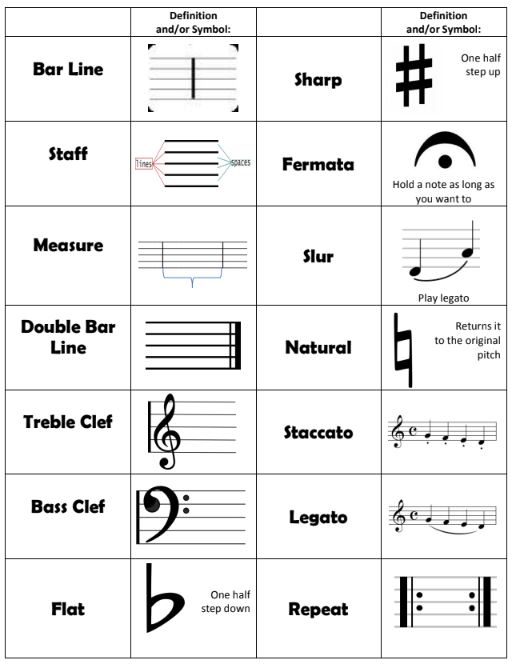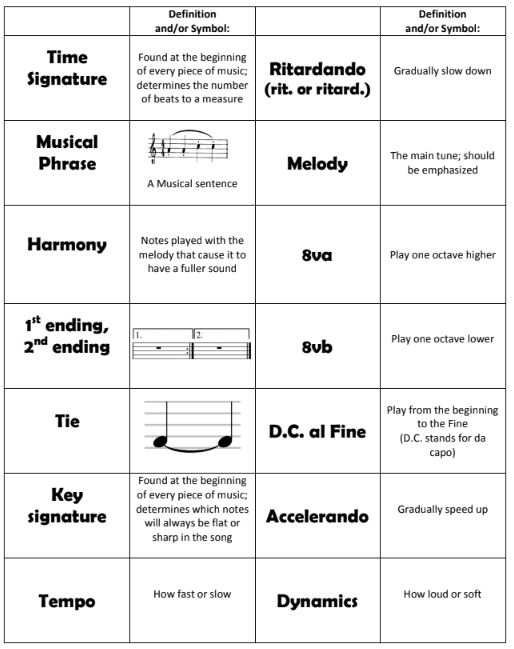Music theory is an important part of your musicianship so you may be finding a need to work on it a little more. Music theory can come with just playing your instrument, but it’s a good idea to make sure that you aren’t missing anything major in your music theory education. Here are some ideas to get you practicing your music theory.

1. Practice the note names.
One of the key aspects to music theory is being able to “talk the talk”. You need to be able to identify and name notes so that others can know what you are referring to. So while you don’t have to know the names of the note in order to play them, you will want to know the names so that you can hold an intelligent conversation about it.
There are several ideas on practicing note names.
You can practice and study music note names on this Free Online Music Note Flashcards Game. Work through them until you can name off all of the notes in less than a minute! My 6 year old daughter can name off all the bass and treble cleff notes in that amount of time, so I know you can too!
You can also create words with the note names, just like in this game of Word Search with Music Notes! Music Theory Game.
2. Practice music rhythm notes and rests.
To be competent in music theory, you will definitely want to know and practice your music rhythms. Be able to identify a quarter note, eighth note, sixteenth note, half note, dotted notes, and whole notes and rests. Then, practice tapping out different rhythms.
Take the song that you will be learning and see if you can clap out the rhythm before you play the notes. You may do this already and didn’t even realize that you were practicing your music theory!
You can try to see if you can fill out this Create a Music Clown Worksheet to test your knowledge of basic music rhythm.
3. Practice basic music terms with flashcards.
It’s important to know the names of the symbols in the music and what they mean. If you ever run across a term or a symbol you don’t recognize or can’t name, then take the time to look it up. You will want to know all of the basic music terms.
One way you can do this is with some flashcards. I created these basic music terms for my piano students:
Download a PDF at Musical Terms & Concepts from PianoTels.pdf (966 downloads)


4. Learn and practice scales.
Learning your scales is a fabulous way to practice your music theory. As you learn your scales, you learn your key signatures and what notes are in each scale. There is an extensive article on How to Practice Piano Scales: Everything You Need to Know that is definitely worth checking out. It provides tips and steps to practicing your scales correctly and getting to the point of mastering them.
As you practice your scales, try different rhythms. Change it up by accenting a different key every time. Practice with a metronome and keep your hand position correct. This is definitely a hands-on approach to learning music theory!
5. Memorize key signatures.
Right along with practicing your scales, memorize those key signatures. The Circle of Fifths is a diagram that basically shows you all that there is to know with key signatures in one, very cool diagram. You see, there is a pattern to key signatures.
You could have a whole discussion on the Circle of Fifths. It has got to be my favorite aspect of mathematics in music theory. I just can’t get over how perfectly reasonable the Circle of Fifths is. When you can understand the Circle of Fifths, and be able to create a chart yourself, then you will have made a giant step to figuring out music theory!
A great article for helping you understand the Circle of Fifths and get those key signatures memorized, is Key Signature Hacks from musicnotes.com.
A common practice of memorizing sharps and flats in a key signature is to use a mnemonic:
Father Charles Goes Down And Ends Battle
From left to right, you will find the sharps, F, C, G, D, A, E, and B. From right to left, you will find the flats, B, E, A, D, G, C, and F.
6. Practice identifying chords and inversions.
Chords and scales are the building blocks of music. Knowing them, you will begin to understand music and where it comes from. Each song builds off of the building blocks of these chords and scales, and thus they are worth practicing!
It’s best to be able to identify the chords and inversions when you are playing the music. The more beginning students will definitely find some basic chords, such as the root chord.
The most basic chords that you will find most often are these 14 common major and minor chords: C, Cm, D, Dm, E, Em, F, Fm, G, Gm, A, Am, Bb, and Bbm.
You will find these major and minor chord charts and downloadable flashcards if you click on the link.
As you study these chords, you will notice that major and minor chords only differ by one key – the middle note is lowered half a step.
Another quick hint if you are learning these chords for the first time, is to realize that all chords are found very simply. Each major chord has a pattern of 4 half steps, then 3 half steps. Minor chords are the opposite, with 3 half steps, and then 4 half steps.
You can advance to identifying different chords and inversions such as you can find on musictheory.net. Try identifying the chords in their flashcard game and see how many you can conquer.
Before you begin playing your piano piece, go through and see what chords you can find. Try and find them blocked or broken. Try and find the patterns of the chords in the music, as often times you will find them in a continual pattern.
7. Practice identifying intervals in your music.
Just as with chords, you can identify intervals in your music. As you do so, it will help you to play quicker and master the songs a little easier. That’s why I would suggest a games such as Interval Explosion! which is a game I use with my students. It’s amazing how quickly they can master these intervals. You want to be able to identify them by sight as quickly as possible.
Ideally, you will want to be able to identify them regardless of where the interval is found on the piano. There are some quick tips and tricks to figuring out those intervals. Odd intervals (3rds, 5ths, and 7ths) have a chord that has both notes on a line, or both notes on a space. Even intervals (2nd, 4ths, 6ths, and 8va or octaves) have a chord that has one note on a line and one note on a space.
Another game you can try out with intervals is The Interval Game of Sorry.
8. Practice ear training.
Ear training is an important part of practicing your music theory. Being able to identify when you are playing correctly and when you are not — just by listening to yourself, will help you a great deal in your development as a musician.
Practice ear training by identifying intervals. When you are in the car listening to the radio, see if you can identify what the intervals are in the music. One helpful way to do this is to compare the ear training you may already have built in.
For example, a major 2nd is the interval in Happy Birthday. So you can listen to the interval and see if it sounds like Happy Birthday, and if so, it is a 2nd!
Ear Master has a fabulous list of famous intervals songs that will help you identify them by ear. Go ahead and pick out some of your favorite “identifier” songs and give is a try!
Other ways of practicing your ear training include some practices that you can find online, such as this ear training on tonedear.com. This helps you practice your interval ear training for sure. It’s good for me to continue to practice, though it can be frustrating at times!
Related Articles:
30+ Fun & Easy Music Theory Games and Activities for Piano Students
Tel loves her life as a piano player, a piano teacher, and a mom. Amid piano blogging, piano teaching, and piano playing, she loves a chance to fit in a good exercise class, volunteer at her kids’ school and at her church, and go on long dates with her husband. Full bio at About Tel.



strictly speaking this isn’t music theory. It’s nomenclature and notation. But every body of knowledge has a specialized vocabulary, and a lot of tradition.
Circle of 5th is a good way to fill in a lot of information. But why does it work? The why would be theory.
Why do certain chord progressions work? And the same chords in a different order sound off?
Why is there only two keys with 3 flats. And why are the 3 flats in the place. Why can’t w have a key with Gb , Ab Bb and no others? This leads into all those weird modes that come from before equal-termpered scales.